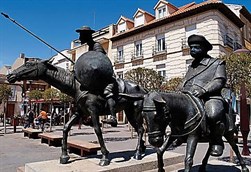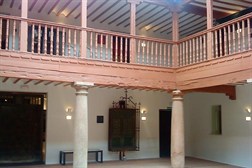Cervantes in Alcázar de San Juan: a Baroque controversy
 The town of Alcázar de San Juan (Ciudad Real) is at the center of a controversy that has its origins in the Early Modern period. There was no doubt that the famous author of the Quijote, Cervantes was born in Alcalá de Henares, until, in 1748, the act of the baptism of a certain Miguel de Cervantes Saavedra was found in the church of Santa María la Mayor in Alcázar de San Juan. The defenders of the origin of Cervantes in Alcázar de San Juan is based on the fact that the writer had personally known Alcázar de San Juan. However, after years of controversy it was confirmed that the Miguel de Cervantes from Alcázar could not be the author of the Quijote because of the date of birth, November 9, 1558: he was in fact 11 years younger (the Cervantes in Alcalá, the authentic one, was born in 1547) and the events of the author’s life would not have been able to coincide with the dates (this is the case, for example, with the Battle of LepantoWas a naval battle that took place on 7 October, 1571 and that pitted the Holy League (Spanish Monarchy, the Duchy of Savoy, the Papacy and the Republics of Venice and Genoa) against the Ottoman Empire. The victory put a stop to Ottoman expansion in the Christian West., in which the alcazareño Cervantes could not have participated because he would have been too young). Even today, however, there are staunch defenders of the thesis that holds that Alcazar de San Juan was the birthplace of Cervantes, and squares, museums and monuments recall the imprint of the Quijote as the basis of culture, tourism (image 1 of the Plaza de España with don Quijote and Sancho Panza), gastronomy and landscape of this center of Castilla-La Mancha.
The town of Alcázar de San Juan (Ciudad Real) is at the center of a controversy that has its origins in the Early Modern period. There was no doubt that the famous author of the Quijote, Cervantes was born in Alcalá de Henares, until, in 1748, the act of the baptism of a certain Miguel de Cervantes Saavedra was found in the church of Santa María la Mayor in Alcázar de San Juan. The defenders of the origin of Cervantes in Alcázar de San Juan is based on the fact that the writer had personally known Alcázar de San Juan. However, after years of controversy it was confirmed that the Miguel de Cervantes from Alcázar could not be the author of the Quijote because of the date of birth, November 9, 1558: he was in fact 11 years younger (the Cervantes in Alcalá, the authentic one, was born in 1547) and the events of the author’s life would not have been able to coincide with the dates (this is the case, for example, with the Battle of LepantoWas a naval battle that took place on 7 October, 1571 and that pitted the Holy League (Spanish Monarchy, the Duchy of Savoy, the Papacy and the Republics of Venice and Genoa) against the Ottoman Empire. The victory put a stop to Ottoman expansion in the Christian West., in which the alcazareño Cervantes could not have participated because he would have been too young). Even today, however, there are staunch defenders of the thesis that holds that Alcazar de San Juan was the birthplace of Cervantes, and squares, museums and monuments recall the imprint of the Quijote as the basis of culture, tourism (image 1 of the Plaza de España with don Quijote and Sancho Panza), gastronomy and landscape of this center of Castilla-La Mancha.
 In this regard it should be recalled the Museo del Hidalgo, opened in 2011 in a restored two-storey mansion of the sixteenth century, with a central courtyard (image 2), which recreates the environment and exposes the objects which were typical of the area during the Baroque period, from the mills to the products of the earth, from the cuisine to the furniture typical of the era.
In this regard it should be recalled the Museo del Hidalgo, opened in 2011 in a restored two-storey mansion of the sixteenth century, with a central courtyard (image 2), which recreates the environment and exposes the objects which were typical of the area during the Baroque period, from the mills to the products of the earth, from the cuisine to the furniture typical of the era.
Finally, we also bring attention, in the vicinity of this town, to el Cerro (hill) of San Antón, where there are windmills, now restored, which are reminiscent of the famous episode in which the protagonist Don Quixote fought windmills believing he was fighting against fearsome giants. In the Baroque period there were to be up to 20 mills near Alcazar de San Juan, but there are only 4 which remain today. This hill is also known as the Mirador de La Mancha, because it is possible to admire the typical landscape of La Mancha made of yellow and green colors, drawn from the fields of wheat and barley and that have changed very little if at all from the Baroque age to today.
